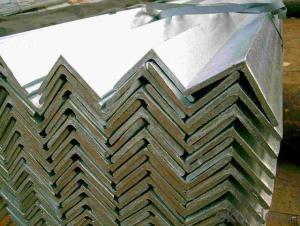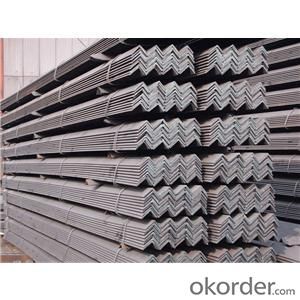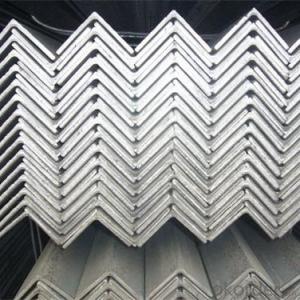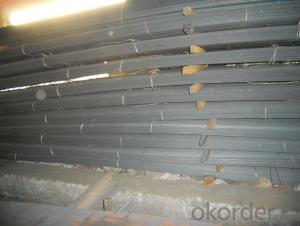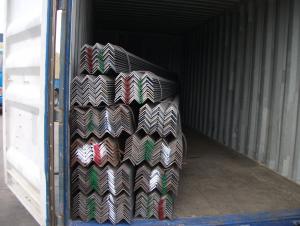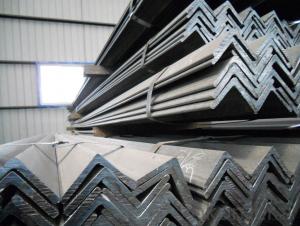Hot Rolled Equilateral Small Angle Steel High Quality
- Loading Port:
- China main port
- Payment Terms:
- TT OR LC
- Min Order Qty:
- 50 m.t.
- Supply Capability:
- 10000 m.t./month
OKorder Service Pledge
OKorder Financial Service
You Might Also Like
Specification
Hot Rolled Equilateral Small Angle Steel
Product Description:
OKorder is offering Hot Rolled Equilateral Small Angle Steel at great prices with worldwide shipping. Our supplier is a world-class manufacturer of steel, with our products utilized the world over. OKorder annually supplies products to European, North American and Asian markets. We provide quotations within 24 hours of receiving an inquiry and guarantee competitive prices.
Product Applications:
Hot Rolled Equilateral Small Angle Steel are ideal for structural applications and are widely used in the construction of buildings and bridges, and the manufacturing, petrochemical, and transportation industries.
Product Advantages:
OKorder's Hot Rolled Equilateral Small Angle Steel are durable, strong, and resist corrosion.
Main Product Features:
· Premium quality
· Prompt delivery & seaworthy packing (30 days after receiving deposit)
· Corrosion resistance
· Can be recycled and reused
· Mill test certification
· Professional Service
· Competitive pricing
Product Specifications:
Manufacture: Hot rolled
Grade: Q195 – 235
Certificates: ISO, SGS, BV, CIQ
Length: 6m – 12m, as per customer request
Packaging: Export packing, nude packing, bundled
Chinese Standard (H*W*T) | Weight (Kg/m) | 6m (pcs/ton) | Light I (H*W*T) | Weight (Kg/m) | 6m (pcs/ton) | Light II (H*W*T) | Weight (Kg/m) | 6M |
100*68*4.5 | 11.261 | 14.8 | 100*66*4.3 | 10.13 | 16.4 | 100*64*4 | 8.45 | 19.7 |
120*74*5.0 | 13.987 | 11.9 | 120*72*4.8 | 12.59 | 13.2 | 120*70*4.5 | 10.49 | 15.8 |
140*80*5.5 | 16.89 | 9.8 | 140*78*5.3 | 15.2 | 10.9 | 140*76*5 | 12.67 | 13.1 |
160*88*6 | 20.513 | 8.1 | 160*86*5.8 | 18.46 | 9 | 160*84*5.5 | 15.38 | 10.8 |
180*94*6.5 | 24.143 | 6.9 | 180*92*6.3 | 21.73 | 7.6 | 180*90*6 | 18.11 | 9.2 |
200*100*7 | 27.929 | 5.9 | 200*98*6.8 | 25.14 | 6.6 | 200*96*6.5 | 20.95 | 7.9 |
220*110*7.5 | 33.07 | 5 | 220*108*7.3 | 29.76 | 5.6 | 220*106*7 | 24.8 | 6.7 |
250*116*8 | 38.105 | 4.3 | 250*114*7.8 | 34.29 | 4.8 | 250*112*7.5 | 28.58 | 5.8 |
280*122*8.5 | 43.492 | 3.8 | 280*120*8.2 | 39.14 | 4.2 | 280*120*8 | 36.97 | 4.5 |
300*126*9 | 48.084 | 3.4 | 300*124*9.2 | 43.28 | 3.8 | 300*124*8.5 | 40.87 | 4 |
320*130*9.5 | 52.717 | 3.1 | 320*127*9.2 | 48.5 | 3.4 | |||
360*136*10 | 60.037 | 2.7 | 360*132*9.5 | 55.23 | 3 |
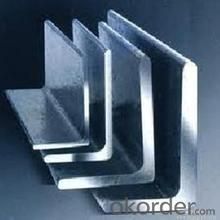
- Q: How do you prevent corrosion between steel angles and other materials?
- One effective way to prevent corrosion between steel angles and other materials is by applying a protective coating or paint to the surface of the steel. This coating acts as a barrier, preventing direct contact between the steel and other elements that may cause corrosion, such as moisture or chemicals. Additionally, ensuring proper ventilation and drainage around the steel angles can help prevent moisture buildup, which is a common cause of corrosion. Regular inspection and maintenance, including cleaning and repairing any damaged coatings, can also help prevent corrosion in the long run.
- Q: What are the typical lengths of steel angles available in the market?
- The market offers a range of steel angle lengths to meet specific project needs and requirements. While there are standard lengths readily available, ranging from 20 to 40 feet, such as 20, 25, 30, 35, and 40 feet, customization is also possible through special orders or fabrication. This flexibility allows for meeting precise project requirements in construction and industrial applications, where steel angles are used for structural support, framing, and bracing.
- Q: What are the common design codes and standards for steel angles?
- The most common design codes and standards for steel angles include the American Institute of Steel Construction (AISC) 360, the European Standard (EN) 10056, and the British Standard (BS) EN 10056. These codes and standards provide guidelines for the design, fabrication, and structural analysis of steel angles, ensuring the safety and reliability of structures that incorporate these structural elements.
- Q: How do you join two steel angles together?
- One common method to join two steel angles together is by using bolts or screws. The angles can be aligned and holes can be drilled through both angles at the desired connection points. Then, bolts or screws can be inserted through the holes and tightened to securely fasten the angles together. Additionally, welding can also be used to join two steel angles together.
- Q: What are the different packaging options for steel angles?
- The different packaging options for steel angles typically include bundles, pallets, or crates. Bundles are commonly used for smaller quantities and are secured with steel straps. Pallets are used for larger quantities and provide ease of handling and transportation. Crates are used for heavy-duty and long-distance shipments, offering added protection and stability.
- Q: What are the common applications of steel angles in the automotive industry?
- Steel angles are commonly used in the automotive industry for various applications such as reinforcing structural components, supporting body panels, creating brackets and mounts, and enhancing overall vehicle safety and stability.
- Q: What is the corresponding length of the root weight in the angle standard?
- General fixed length delivery without weighing, no fixed length delivery is generally applied to weighing sales. Profile fixed length is generally divided into 6 meters, 9 meters and 12 meters, special sizing must be large quantities, consultation with the steel supply.
- Q: How do you calculate the stability of a steel angle column?
- Determining the stability of a steel angle column involves considering several crucial factors. The first step is to calculate the slenderness ratio of the column, which is the ratio between its effective length and its least radius of gyration. This can be done using the following formula: Slenderness ratio = (Effective length of column) / (Least radius of gyration) To find the least radius of gyration, the dimensions of the angle section must be used. For a steel angle, an approximation can be made by taking the average of the two legs of the angle section and dividing it by the square root of 3. Once the slenderness ratio is determined, it is necessary to assess whether the column is classified as long or short. If the slenderness ratio is below the critical value, typically around 50 for an angle column, it is considered short, and its stability primarily depends on its strength. In such cases, the column can be designed based on its ability to resist axial compression and flexural buckling. However, if the slenderness ratio surpasses the critical value, the column is classified as long, and its stability depends on its capacity to resist lateral-torsional buckling. In these instances, additional calculations and considerations are required to ensure the column remains stable. For long angle columns, the critical load at which lateral-torsional buckling may occur can be determined using various formulas and methods, such as the Euler formula, the Perry-Robertson formula, or finite element analysis. These calculations take into account various parameters, including the moment of inertia, modulus of elasticity, and length of the column. It is important to acknowledge that stability calculations for steel angle columns can be intricate and necessitate expertise in structural engineering. It is strongly advised to consult with a qualified professional or refer to relevant design codes and standards, such as the American Institute of Steel Construction (AISC) Manual, for accurate and reliable calculations.
- Q: Are there any environmental benefits of using steel angles?
- Using steel angles has numerous environmental advantages. To begin with, steel is one of the most recycled materials globally. When steel angles are no longer needed, they can be easily recycled into new steel products, thereby decreasing the demand for new steel production. This recycling process consumes less energy and resources compared to manufacturing steel from raw materials, resulting in significant energy savings and reduced carbon emissions. Furthermore, steel is a durable material with a long lifespan. This means that steel angles require less frequent replacement than other materials, leading to a reduction in waste generation. Steel's durability also means that it requires less maintenance and repairs over time, further minimizing its environmental impact. Moreover, steel is resistant to fire, pests, and rot, which reduces the necessity for chemical treatments and preservatives that can harm the environment. Additionally, steel angles have a high strength-to-weight ratio, meaning that less material is needed to achieve the same structural integrity compared to other materials. This not only reduces the amount of raw materials needed but also decreases transportation costs and fuel consumption during construction. Lastly, steel is highly versatile and can be used in various applications, such as construction and manufacturing. This versatility enables the creation of innovative and sustainable designs that optimize energy efficiency and decrease environmental impact. For instance, steel angles can be utilized in the construction of energy-efficient buildings that incorporate renewable energy systems, ultimately reducing overall energy consumption and greenhouse gas emissions. In conclusion, utilizing steel angles provides numerous environmental benefits, including decreased energy consumption, lower carbon emissions, reduced waste generation, and increased durability. These factors make steel angles a sustainable and environmentally-friendly choice for a range of applications.
- Q: What is the minimum radius for a curved steel angle?
- The minimum radius for a curved steel angle depends on various factors, including the thickness and width of the steel angle, as well as the desired degree of curvature. In general, the minimum radius for a curved steel angle is determined by the limitations imposed by the material's ability to bend without causing permanent deformation or cracking. It is important to consult the manufacturer's guidelines or an engineer specializing in structural steel to determine the specific minimum radius for a given curved steel angle.
Send your message to us
Hot Rolled Equilateral Small Angle Steel High Quality
- Loading Port:
- China main port
- Payment Terms:
- TT OR LC
- Min Order Qty:
- 50 m.t.
- Supply Capability:
- 10000 m.t./month
OKorder Service Pledge
OKorder Financial Service
Similar products
Hot products
Hot Searches
Related keywords
